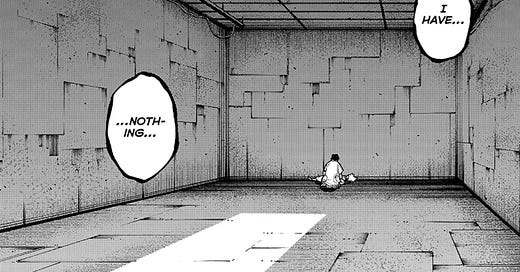This panel legit took my breath away, I’m not being dramatic. Gachiakuta has done a great many things in its short existence (thus far), from incredible art direction and character design, to facial expressions that are literally imprinted in my brain, to setting that completely changed my appreciation of setting.
But then this panel happened, and it did yet another something. It created a standalone work of art.
This is from Chapter 15, page 7.
Context: Rudo is laying on the ground and Regto, his guardian, is kneeling next to him. This is a flashback. Rudo is remembering his time with Regto, a particularly dark time when he has just been taken in and given a place to live. This is before he discovered what his “thing” is, that turns out to be his power. So at this moment, he has nothing, as he says, but he soon discovers that he can see the value in everything, and that this great openness is an opportunity, not a void.
Rudo’s life has not been easy. After being taken in by Regto and given the start of a happy life, Regto is killed and Rudo is framed for it (this all happens in the first volume). Rudo is thrown into the garbage realm as punishment, where he learns more about his obsession with hoarding objects, and he starts to grow into the best version of himself.
That might be more context than you think you need to know, but bear with me.
In this panel, Rudo has nothing, but he’s been given this space to live. Without understanding himself and his needs, he doesn’t know what to fill it with, he doesn’t know who he is or what he stands for. He has, as he says in this panel, nothing. Nada. That’s a great starting point for a character, but how do you really show just how empty his life is?
This panel, that’s how. The sheer size of this space immediately swallows up tiny Rudo, who’s laying on the ground in front of Regto. You can’t even see Rudo. You know he’s there, but aside from his goofy hair, there is no discernible quality to be seen. He might as well not exist, you might think, both in this panel and in the story. Remember, he has nothing.
It’s a visual representation of how small Rudo feels. But he does have one thing. He has Regto. And that is a value not lost on Rudo, even if he’s struggling to grasp it in this moment.
This feels like ground zero for Rudo, but little does he know, all he needs to restart is in the room already. It’s Regto, the father-figure he never knew he needed. With Regto’s help, Rudo will fill this room with things and learn to find joy. But for the moment, this cavernous space is everything that’s wrong with Rudo, and when you factor in the fact that Regto is soon to die, you can start to think about how this panel will look without Regto in it. Rudo would be truly alone. Truly at ground zero. And that’s where Rudo’s story begins.
Lastly, a visual element that was the icing on the cake, pardon the cliche—the light from the door isn’t even reaching Rudo. So when he says he has nothing, he means he doesn’t even have the light. That’s heavy.
Please applaud Kei Urana with me. This is marvelous.





This whole series is really art history -- formal analysis, etc. Very cool.
I just love how a panel like this is something only visual storytelling (like manga and anime) can achieve: all that meaning convey through a single image with the bare minimum of words to anchor it. And I hadn't noticed the light until you mentioned it, but you're so right! So clever!